2011 Academy Member Joe Dunton, (UK) |
Read more
at in70mm.com The 70mm Newsletter |
| Written by: Tony Sloman, London, UK | 26. March 2011 |
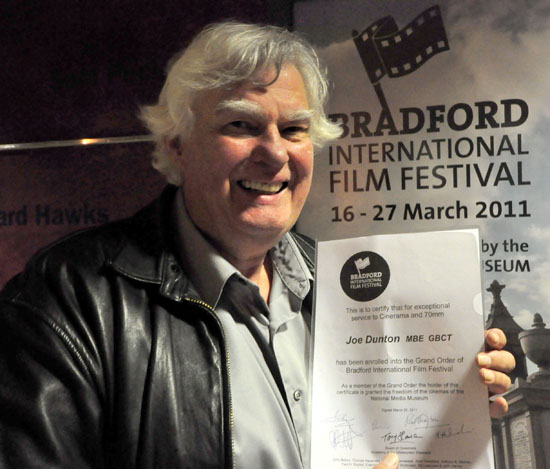 Joe
Dunton with his award. Image by Thomas Hauerslev Joe
Dunton with his award. Image by Thomas HauerslevLittle did I think, when I started work as additional film editor on "Dance Craze" back in 1981, just before Christmas, that I would find myself here, at the wonderful Widescreen Weekend, Bradford, some 30 years later, welcoming that film producer, Joe Dunton and screening his marvellous 70mm print of that incredibly exciting rock movie we worked on all those years ago. But why should I be surprised, because by 1981 - the year of "Dance Craze" - Joe Dunton had already carved a remarkable career in the world of the wide screen, and after producing "Dance Craze", Joe Dunton went on to even greater glory internationally, securing a reputation second to none in perfection in cinematography. Let me try to elaborate, and since you’re all here to watch movies, I’ll try to encapsulate Joe’s career to date as briefly as possible, and hopefullyyou’ll begin to realise what a very special man he is, and what a wonderful asset to the British film industry, and in particular to widescreen itself. |
Further
in 70mm reading: The Making of "Dance Craze" by Joe Dunton Joe Dunton Q/A Widescreen Weekend 2011 Gallery highlights: Stanley Long | Claire Bloom | Reception | Friday | Saturday | Sunday | Monday Academy of the Widescreen Weekend Widescreen Weekend home Internet link: |
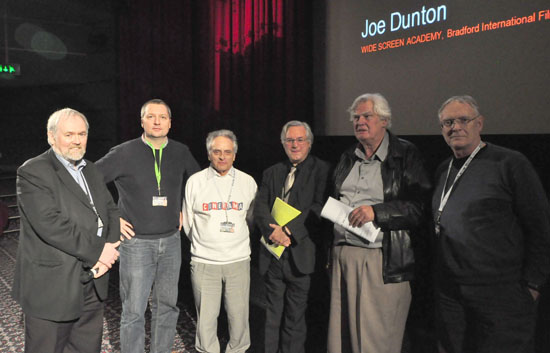 The
Academy line up: Bill Lawrence, Thomas Hauerslev, Keith Swadkins, Tony
Sloman, Joe Dunton, and Paul Rayton. Image by Mark Davis The
Academy line up: Bill Lawrence, Thomas Hauerslev, Keith Swadkins, Tony
Sloman, Joe Dunton, and Paul Rayton. Image by Mark DavisJoe Dunton started his career in England as a video engineer with Pye London Ltd and his first feature work was on the racing epic "Le Mans" starring Steve Mcqueen. Working for Samulesons and then Panavision, he then famously converted a Mitchell camera for cinematographer Ossie Morris on Carol Reed’s "Oliver!" creating the very first attachment for video assist, providing Sir Carol and his team of seven choreographers quick and easy access to judging the performances of some 400 dancers in the major musical numbers. Video assist is now, of course, commonplace. Joe’s love of and fascination with anamorphic processes is legendary:- He founded Joe Dunton Cameras in 1976 and amongst his inventions can be included: the development of the first heated camera eyepiece; the ladderpod; the first assist for the Louma camera crane, the Moy Bazooka, the Mitchell Vitesse geared camera crane; plus a marvellous HD camera magazine that is absolutely interchangeable with traditional film magazines. Plus he is currently working on a single lens 3D system to be called JD3D ... i’m joking he hasn’t named his 3D process yet! "Dance Craze" led to Joe actually creating a new anamorphic process using lenses that he physically ground himself. |
|
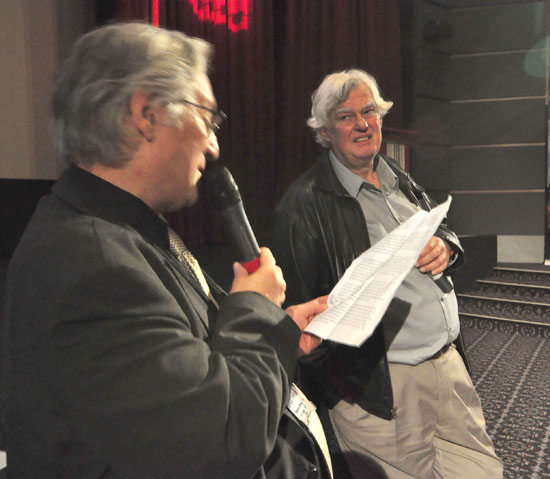 Tony
Sloman reading. Image by Thomas Hauerslev Tony
Sloman reading. Image by Thomas HauerslevAnd here I must make a confession. Joe asked me to come up with a new name for this process - and I couldn’t. I failed Joe and with a heavy heart completely failed to come up with a new moniker, a successor to CinemaScope or Panavision or Technirama. The closest I could achieve was lenscope and I was so ashamed of it I didn’t even tell Joe. But Joe, uniquely, came up with JDC Scope, effectively standing for Joe Dunton Cameras Scope, the only ‘scope process ever to incorporate the name of its inventor. And what a process! Pin sharp registration, superb depth of focus, a truly unique level of quality - and recognised as such, and quickly. And where, I hear you think, would you have seen this lens used? |
|
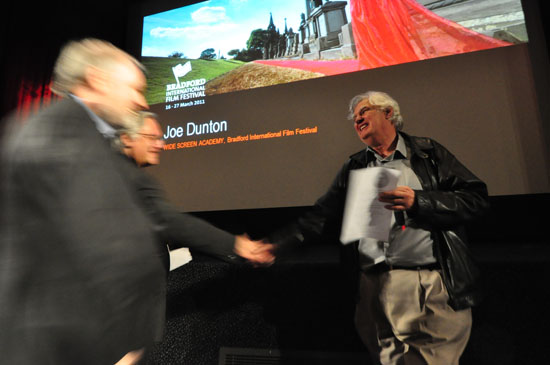 Well folks, only in some of the most famous and successful widescreen films
of your lifetimes - where to start? How about "Star Wars - Return of the
Jedi", and "The Phantom Menace". And "Harry Potter and the
Prisoner of Askaban" and "Harry Potter and the Order of the Phoenix".
And "Gladiator", "The Dark Knight", "Hannibal", "Evita",
and "Labyrinth" and "Legend" and "The Bounty" and "Yentl"
and oh goodness, talk about endless lists, 213 movies and TV series to
date!! Directors such as Stanley Kubrick on "A Clockwork Orange" and
subsequent features and producers like Steven Spielberg on "Poltergeist",
swear by Joe Dunton, and the results achieved by using Joe’s cameras and
lenses. Joe has headed up Panavision as well as his own JDC and is currently
President of the British Society of Cinematographers in addition to being
chairman of all the cine Guilds of Great Britain and has been honoured and
recognised internationally: the Lifetime Achievement Award from the Society
of Camera Operators, presented at the American Academy of Motion Picture
Arts and Sciences; The Michael Balcon Award at BAFTA for Outstanding
Contribution to British Cinema; and last but certainly and emphatically not
least, the MBE at the hands of Queen Elizabeth II for services to the UK
camera and film industry. Well folks, only in some of the most famous and successful widescreen films
of your lifetimes - where to start? How about "Star Wars - Return of the
Jedi", and "The Phantom Menace". And "Harry Potter and the
Prisoner of Askaban" and "Harry Potter and the Order of the Phoenix".
And "Gladiator", "The Dark Knight", "Hannibal", "Evita",
and "Labyrinth" and "Legend" and "The Bounty" and "Yentl"
and oh goodness, talk about endless lists, 213 movies and TV series to
date!! Directors such as Stanley Kubrick on "A Clockwork Orange" and
subsequent features and producers like Steven Spielberg on "Poltergeist",
swear by Joe Dunton, and the results achieved by using Joe’s cameras and
lenses. Joe has headed up Panavision as well as his own JDC and is currently
President of the British Society of Cinematographers in addition to being
chairman of all the cine Guilds of Great Britain and has been honoured and
recognised internationally: the Lifetime Achievement Award from the Society
of Camera Operators, presented at the American Academy of Motion Picture
Arts and Sciences; The Michael Balcon Award at BAFTA for Outstanding
Contribution to British Cinema; and last but certainly and emphatically not
least, the MBE at the hands of Queen Elizabeth II for services to the UK
camera and film industry. |
|
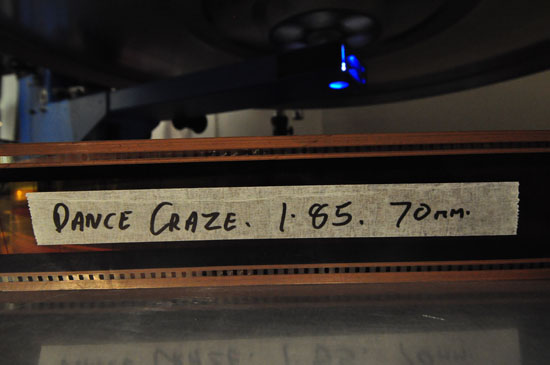 ‘Enough awards already!’ you’re thinking. But Joe Dunton is a man who has
shown a love, affection and understanding of the Wide Screen like no other.
(And I’m not just saying that because he once loaned me his own personal
VistaVision copy of "Battle of the River Plate" to view privately!) ‘Enough awards already!’ you’re thinking. But Joe Dunton is a man who has
shown a love, affection and understanding of the Wide Screen like no other.
(And I’m not just saying that because he once loaned me his own personal
VistaVision copy of "Battle of the River Plate" to view privately!)And so, humbly, to this nicest of all modest men, to a man who has wide-screen sprockets running through his veins, who has done more to achieve widescreen perfection that any one single individual ever since Henri Chretien invented what we now know as CinemaScope, to Joe Dunton, MBE, we are proud to invite into the select Wide Screen Academy, and to honour him ....on the 30th Anniversary of his own "Dance Craze"; I now call on Bill Lawrence to present the honour ... Bill ... |
|
|
Go: back
- top - back issues
- news index Updated 22-01-25 |
|
